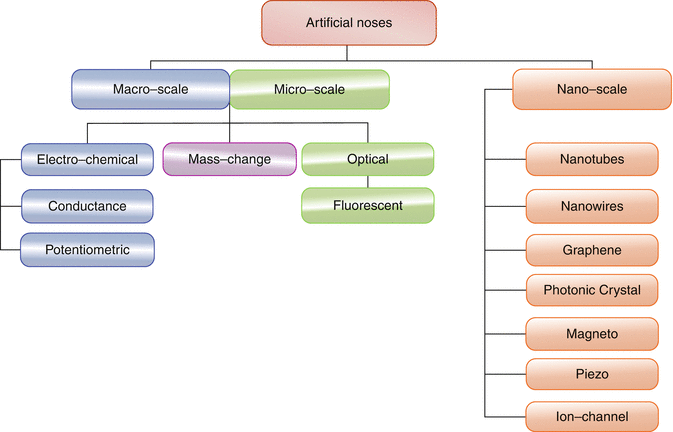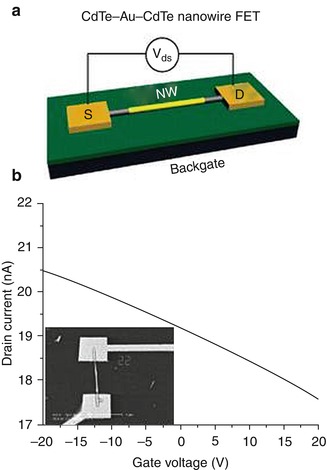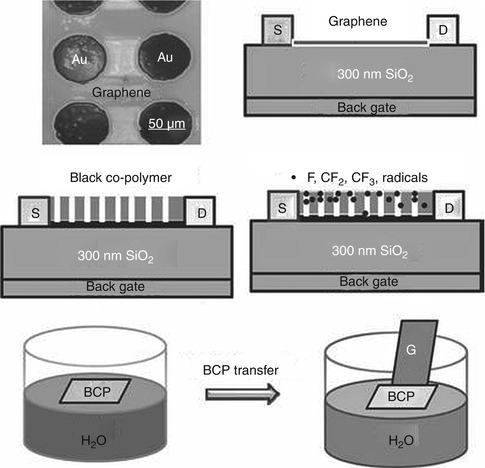Fig. 39.1
Thin-film electrodes process to the sound from 128 different channels in comparison to standard 16–22 channel implants (Source: http://www.engadget.com/2006/02/09/new-type-of-cochlear-implant-to-improve-hearing/)
39.4.1.3 Design an Artificial Nose (Nanonose)
One of the areas with high-implementation potential for nanosensors is the artificial nose studies. Studies are continuing on systems to capture and process odor molecules (Fig. 39.2). Systems designed for this purpose involve use of receptors, transmitters, receivers, and a processor. Receptors used in these systems are manufactured with nanofabrication or MEMS (micro-electromechanical systems) technology. Nanowire and graphene sensors can also be used to produce nanonose (Figs. 39.3 and 39.4). Multisegmented nanowires via surface functionalization method can be used for detection of biological or odor molecules. P-type multisegmented nanostructures are in a back-to-back Schottky diode configuration. Au-part of the multisegment can be surface functionalized to increase the sensitivity of the nanowire sensor with specific sensing molecules. Attachment of odor molecules on Au-portion of the nanowire can modulate the Fermi level of the heterojunction device which leads to detection of the desired molecules. Such multisegmented nanowire sensors can be fabricated into an array format for detection of different types of odor molecules or biological agents.




Fig. 39.2
Taxonomy of nose-like sensors (Adapted from The MITRE Corporation, McLean, ©1997–2006)

Fig. 39.3
(a) Schematic of CdTe-Au-CdTe nanowire field-effect transistor. (b) SEM image of CdTe-Au-CdTe nanowire FET (Source: Wang and Ozkan 2008)

Fig. 39.4
Graphene-based electronic sensors are successfully used for chemical, biological, and gas sensing (Source: Guo et al. 2012)
Similarly, graphene field-effect transistors arrays can be used for sensing as well. Using graphene sensors, pH, DNA, and vapor detection have been demonstrated. Stability and reliability of such sensors became questionable due to graphene’s fast response to its environment. For this purpose, extraordinary electrical property of a graphene transistor is combined with a cover of block copolymers where nanometer-scale openings provide access to the graphene surface where sensing can occur (Fig. 39.4). Gas/odor molecules can penetrate through the small holes across the block copolymer layer and reach to the graphene layer underneath. Interaction with these molecules and graphene surface leads to a shift in Dirac point of the transistor. Electrical shift in the signal is basically the senor output.
Arrays of graphene field-effect transistors with block copolymer on the surface can be fabricated and used for detection of different molecules. Block copolymers in appropriate volume fractions and molecular weights can provide control over the morphology and size/separation distance of cylindrical microdomains. These domains can be adjusted based on the size of the molecules or biological agents to be detected. As sensor output, the amount of Dirac point shift for different molecules is expected to be different which is important for the array-formatted sensors.
Today, electro-physiological basis of odor detection process is better understood, and in the upcoming period, the most important goal is to create a different type of nanosensors structure that will bring together an integrated system.
With the successful results obtained from studies based on this type of nanosensor will be able to develop an artificial nose.
39.4.1.4 Cancer
It has not gained enough success at the level of meeting the needs of the society regarding cancer, which has one of the highest mortality rates as a disease group in the world and on which billions of dollars are spent every year all around the world for understanding tumoral pathophysiology, for developing effective treatment agents, and for the treatment of patients. Without having the full understanding of chaotic dynamics of tumor tissue, it is not possible to administer an effective anticancer treatment. Today, it has been commonly discussed about the wrongs known as right on the topics of molecular oncology approaches and cancer pathogenesis; accordingly, a new strategy in cancer therapy should be developed.
Stay updated, free articles. Join our Telegram channel

Full access? Get Clinical Tree


